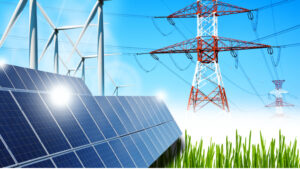Clean technology aims to protect both the environment and economic prosperity, with an additional social aspect prioritizing oppressed communities’ needs. Global sustainability challenges such as climate change, biodiversity loss, resource depletion, and pollution require systemic solutions. Meeting them involves technological innovation, social transformations, and international cooperation—with clean technology playing an essential part in solving them all.
Renewable Energy
Renewable energy is one of the most powerful tools in our fight against global warming and climate change. Unlike fossil fuels that have a limited supply and greater impacts on the environment, solar and wind energy sources such as solar PV or wind power can be infinitely replenished, making renewable energies an integral component of solutions needed to reach net-zero emissions and decrease pollution levels.
Solar energy is an efficient source of electricity that can also be used for heating and cooling homes and businesses, powering electric vehicles, and feeding back into the grid. Clean tech” refers to technologies that improve efficiency and reduce waste, like solar and wind technologies, but can also include technologies that increase productivity. Clean technologies help businesses reduce their environmental impact while potentially saving money over time—all while decreasing fossil fuel dependence for future generations.
Energy Storage
As we progress toward a more sustainable future, energy storage is becoming an ever-more critical element. It enables us to increase renewable sources such as solar, wind, and distributed energy resources reliability while creating grid efficiencies and capabilities that reduce greenhouse gas emissions.
Yotta employs cutting-edge batteries to streamline the solar process, while Fervo Energy and Treetoscope contribute to geothermal power production by optimizing a crucial aspect. All these innovative solutions make sustainable options more accessible and ensure that these options are readily available to consumers today.
Clean tech saw an initial boom during the early 2000s, similar to that of the dot-com bubble, before experiencing a significant dip from 2007 to 2013 due to waning government subsidies and longer development cycles for hardware-focused companies. Now, however, a more sustainable future is within reach due to innovations being made in green energy, carbon reduction, and efficient automation technologies.
Energy Efficiency
Energy efficiency is an integral component of clean technology and sustainability, playing an essential role in business operations by helping reduce emissions and costs. Businesses can use corporate sustainability goals as an opportunity to achieve corporate sustainability targets, particularly among their larger competitors. Many have set ambitious targets to reduce CO₂ emissions and lower environmental impact.
These targets can be difficult to meet; they may require changes to business processes or the adoption of new technologies, so it is essential for companies to rely on smart, data-driven solutions to reach them. That is why Digi offers edge computing as an invaluable way for businesses to continuously enhance their efficiency and sustainability goals using real-time data gathered through edge computing solutions; edge computing enables companies to operate with zero carbon footprints while expanding life cycles on existing machines using less energy, thus helping achieve their sustainability ambitions.
Sustainable Automation
Manufacturing and business sustainable automation reduces energy use and emissions and improves energy efficiency, which ultimately lowers costs while contributing to global sustainability goals. Automation of delivery vehicles using electric self-driving cars has been shown to reduce carbon emissions by 36% while simultaneously improving fuel economy. Meanwhile, robotics systems that monitor equipment health using sensors have the power to extend lifespans while minimizing waste.
Automated data collection enables greater transparency and accountability for environmental practices, helping companies comply with more stringent sustainability regulations. Automated reporting also saves both time and effort when streamlining processes.
At first glance, integrating green technologies may appear costly and complex to businesses; however, with guidance, businesses can easily adopt sustainable automation systems and reap significant advantages. Turck’s smart storage systems with flow and torque sensors offer precise energy consumption monitoring with clear documentation supporting sustainability commitments, providing businesses with an ideal way to reconcile sustainability with profitability and efficiency.
Water Conservation
Clean technology holds great potential to advance sustainability in multiple ways. From reducing energy usage for water treatment to turning wastewater into energy, these innovations can have a tremendous impact on our planet. Water is a precious resource that must be conserved. It plays an essential role in maintaining ecological equilibrium and protecting endangered species. By employing water-saving technologies, we can cut environmental pollution while decreasing risks related to natural disasters.
No matter who you are—be it a homeowner, office worker, or business owner—knowing and understanding the advantages of clean tech is vital to being aware of its benefits. Through employing sustainable practices, you can save money and lower your carbon footprint; what’s more is that by doing your part in making our world better for all of us, it should be celebrated!
The Future of Sustainability
Environmental sustainability refers to the ability for products, services, or industries to exist without draining resources or harming the environment indefinitely. This goal can be reached by using recycled materials, minimizing waste disposal practices, and using renewable sources of energy.
Businesses can reap significant financial and image benefits by adopting sustainable practices in their operations and public image. This could involve using quiet machines, cutting energy usage and recycling waste more effectively, or purchasing from fair trade organizations and limiting greenhouse gas emissions.
Future goals involve the development of technologies to reduce greenhouse gas emissions and climate change while supporting sustainable agriculture and water conservation. To do this, governments, companies, and individuals will all have to commit resources toward making change happen—but the potential rewards can be immense.



